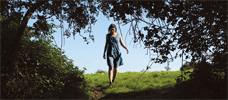Reviews
Levanon
Samuel Maoz
Germany / Israel / France / Lebanon, 2009
Credits
Review by Mike D’Angelo
Posted on 24 September 2009
Source Sony Pictures Classics 35mm print
Categories The 2009 Toronto International Film Festival
The opening shot of Lebanon, Israeli director Samuel Maoz’s fictionalized account of his experiences on the first day of the 1982 Lebanon War, takes in a vast field of sunflowers from roughly eye level, their stalks bowing formally toward the camera. It’s a stunning panorama, and I was mightily impressed when no tank or battalion appeared to provide a painfully blunt contrast. If Maoz has the self-confidence to allow this image to remain allusive and mysterious, I thought, maybe he actually deserves the Golden Lion he just won at Venice. An hour and a half later, however, I wasn’t the least bit surprised to see the film return to that opening shot… only to, heavy sigh, drive a tank straight through it. By that time I’d been pummeled into weary submission, and reminded anew that if war is hell, so are didactic war movies.
Confined almost entirely to the interior of a single tank - a formalist stunt that becomes exponentially less impressive with each successive reel - Lebanon focuses squarely on the four broadly drawn soldiers for whom the vehicle serves as a dank, claustrophic second home. One, reportedly based on Maoz himself, is the unit’s new gunner, who turns out to be too petrified to pull the trigger when the time comes. The other three are, basically: the tough guy, the peacemaker, and the comic relief. As this first harrowing day of combat wears on, with new shit sent fanborne every few minutes or so, this quartet is forced to share what little personal space they possess with both a wounded fellow soldier and a captured Syrian, as well as with the hardass commanding officer who occasionally shows up to bark potentially suicidal orders. All the while, the world outside the tank remains a frightening abstraction, experienced solely by the sounds capable of penetrating thick metal and via the gunner’s viewfinder.
Actually, the film I just described sounds terrific, doesn’t it? And it might well have been, in the hands of a superb visual stylist with no axe to grind. Maoz, however, is well out of his depth here, in terms of both dramaturgy and mise-en-scène. That his characters are one-dimensional and his dialogue purely functional isn’t necessarily a deal-killer—the same is largely true of Kathryn Bigelow’s fine The Hurt Locker, for example. But Bigelow, a consummate action director, understands how to make a film’s very texture and rhythm emotionally expressive, thereby allowing her actors to get away with doing very little. Maoz, on the other hand, looks as if he’d be more at home directing black-box theater. Rather than make the tank an active environment, he treats it essentially as a small, grimy room, which forces his able cast to fill the void with frantic activity and over-the-top emoting.
He also utterly botches what ought to have been his most unnerving effect: the gunner’s viewfinder. Keeping us inside the tank and allowing us to see the outside world only through this tiny circular window was an inspired idea, but Maoz doesn’t understand that the best way to convey maddening, terrifying semi-blindness is to emphasize what’s not quite visible. Instead, he makes such painfully crass moves as a slow, lengthy zoom onto the tear-filled eye of a dying donkey, bludgeoning the viewer with editorial pathos in a way that would make even Steven Spielberg wince. Lebanon’s basic scenario boasts enough built-in tension that the film is never boring, but at no point does it ever suggest the arrival of an exciting new talent. What does it suggest, alongside Waltz With Bashir, is that the First Lebanon War has become Israel’s cinematic equivalent of Vietnam. I still await their Apocalypse Now.
More The 2009 Toronto International Film Festival
-

Huacho
2009 -

A Serious Man
2009 -

Hadewijch
2009 -

Soul Kitchen
2009 -

The Bad Lieutenant: Port of Call New Orleans
2009 -

The Art of the Steal
2009 -

The Ape
2009 -

Trash Humpers
2009 -

My Son, My Son, What Have Ye Done
2009 -

L’Enfer de Henri-Georges Clouzot
2009 -

Father of My Children
2009 -

Police, Adjective
2009 -

Lebanon
2009 -

Chloe
2009 -

The Disappearance of Alice Creed
2009 -

Lourdes
2009 -

Ondine
2009 -

Life During Wartime
2009
We don’t do comments anymore, but you may contact us here or find us on Twitter or Facebook.



